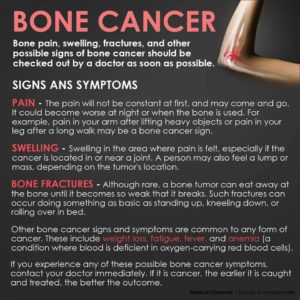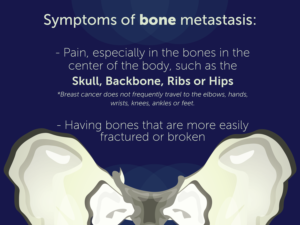Many different treatments can help if your cancer has spread to bone, commonly called bone metastasis. Treatment cannot cure bone metastasis. But it can relieve pain, help prevent complications, and improve your quality of life.
Doctors use two types of treatments for metastatic cancer in the bones. Systemic treatments can reach cancer cells throughout the body. Local treatments directly target the cancer in the bone.
The treatment you get will depend upon:
- Where your cancer started, and the kind of primary tumor you have
- Which bones the cancer has invaded
- The extent of damage to the bones
- Which types of treatment you already have had
- Your overall health
This group of drugs works best in cases where metastasis is weakening the bone.
How it works. You receive bisphosphonates by IV infusion every 3 to 4 weeks. These drugs help with bone metastasis by:
- Slowing bone damage and reducing the risk of bone fractures
- Easing bone pain
- Reducing high levels of calcium in the blood
Possible side effects. The most common ones include:
- Fatigue
- Fever
- Nausea or vomiting
- Anemia
- Bone or joint pain
- Jaw bone pain, swelling, or numbness
- Loss of gum tissue
- Loose teeth
- Infection
Another available treatment is denosumab (Xgeva). It’s given by injection and may work as well as or better than bisphosphonates to prevent fractures. But it also can cause osteonecrosis, as well as low calcium levels in the blood.
Radiopharmaceuticals
These drugs contain radioactive elements that target cancer cells. Doctors tend to use this systemic treatment when the metastasis is stimulating new bone growth. This is more common with prostate cancer.
If your cancer has spread to many bones, these drugs may be a better option than standard radiation, which uses a beam to aim radiation at each bone metastasis. However, sometimes doctors combine radiopharmaceuticals and standard radiation.
How it works. The doctor injects a single dose of the drug into a vein. It then travels to the areas of bone with cancer and gives off radiation to kill the cancer. This single dose may be effective against pain for several months. You can receive another treatment later.
Possible side effects. The most common ones include:
- Infections
- Bleeding
- Temporary increase in pain (flare reaction)
Immunotherapy
This systemic treatment helps your immune system spot and more effectively kill cancer cells. Some methods of immunotherapy have been used for a while, and some are still experimental.
How it works. Immunotherapy works in one of two main ways:
- It boosts your body’s immune system to fight the cancer.
- It uses a man-made version of proteins to kill cancer cells.
Examples of immunotherapy for cancer include:
- Cytokines — substances secreted by the immune system that have an effect on other cells
- Monoclonal antibodies — a class of antibodies made in the lab from a single population of cells
- Tumor vaccines — vaccines using a substance that prompts the immune system to respond to a tumor
Possible side effects. Side effects vary, depending upon the type of immunotherapy. They may include:
- Fever and chills
- Weakness
- Headache
- Nausea or diarrhea
- Rashes
Chemotherapy is a common systemic treatment for bone metastasis. Your doctor will use a type of chemo that is effective against your primary tumor. So, if you have metastatic lung cancer, for example, your doctor will use drugs that are effective against lung cancer.
How it works. Anti-cancer drugs target and curb cancer growth. In most cases, you take chemo by mouth or through a vein (by IV). This can often shrink the tumors, which will ease your pain and help you feel better.
Possible side effects. Chemo can kill normal cells in addition to cancer cells. The side effects you might have will depend on:
- The type and amount of drugs you take
- The length of your treatment
Common side effects of chemotherapy include:
- Loss of appetite, nausea, or vomiting
- Hair loss
- Mouth sores
- Infection
- Bleeding or bruising
- Weakness or fatigue
Your doctor can help you prevent or manage these. Most side effects go away once you stop treatment.
Hormone Therapy
This is another common systemic treatment for cancer that can help with bone mets. Certain hormones, such as estrogen and testosterone, promote the growth of some cancers, such as breast and prostate cancers. Stopping these hormones may reduce bone mets from those cancers.
How it works. There are two main ways to stop the body from making hormones. One is surgery to remove the organs that produce the hormones, such as the ovaries or testicles. More often, doctors prescribe drugs that stop the hormone from being made or block its effect.
Possible side effects. These depend on the specific treatment. Hot flashes are common. Some hormone therapy, such as aromatase inhibitors, may speed up bone loss.
Side effects of hormone therapy for prostate cancer can include:
- Anemia
- Weight gain
- Loss of sex drive
Side effects of hormone therapy for breast cancer can include:
- Blood clots
- Uterine cancer
Radiation Therapy
Radiation is a “local treatment” because it does not affect your entire body. It uses high-energy X-rays or particles to destroy or slow the growth of cancer cells in the bone. It helps most if you have only one or two bone metastases. You may receive it alone or combined with other types of treatment.
How it works. A machine focuses a beam of radiation on the bone metastasis. This treatment, called external beam radiation, lasts only a few minutes. You may receive radiation in one large dose or in smaller amounts over several treatments.
Possible side effects. Early, temporary side effects depend on the location being treated, but may include:
- Fatigue
- Skin changes
Surgery can often help relieve bone metastasis symptoms.
How it works. If a bone is broken, surgery may help relieve pain quickly. Surgery can also help stabilize a weak bone to keep it from breaking. The surgeon may insert:
- Screws
- Rods
- Pins
- Plates
- Cages
Possible side effects. These include the usual risks of any surgery, such as infection.
If surgery is not an option, your doctor may use a cast or splint, or inject bone cement to help you move better and relieve pain.
Ablation
With this local treatment, a needle or probe is put into the tumor to destroy it. Though used more often for other types of metastasis, ablation can help if you have a problem with one or two bone tumors.
How it works. Some methods of ablation use chemicals or alcohol to kill the tumor. Two common methods include:
- Radiofrequency ablation (RFA). A needle delivers an electric current to heat the tumor.
- Cryoablation. A probe is used to freeze the tumor.
Afterward, the doctor may fill the space created by ablation with bone cement to help stabilize the bone.
Possible side effects. This procedure is generally safe but may cause some temporary soreness, swelling, and bruising.
Nerve End Ablation
This noninvasive procedure uses ultrasound energy and MRI technology to provide pain relief by destroying nerve endings in the area of the tumor. Because there is no incision, and no probe is inserted, the procedure is typically done on an outpatient basis with a local anesthetic rather than general anesthesia. While complications are possible, they are rare.
How it works. A specialist uses MRI scanning to target the specific area to be treated with ultrasound. Then, heat that’s made when ultrasound penetrates the targeted tissue destroys nerve endings in the bone around the tumor. The destruction of nerve endings results in pain relief.
Possible side effects. Possible complications include skin burns and damage to heat-sensitive organs that are next to the treated area.

